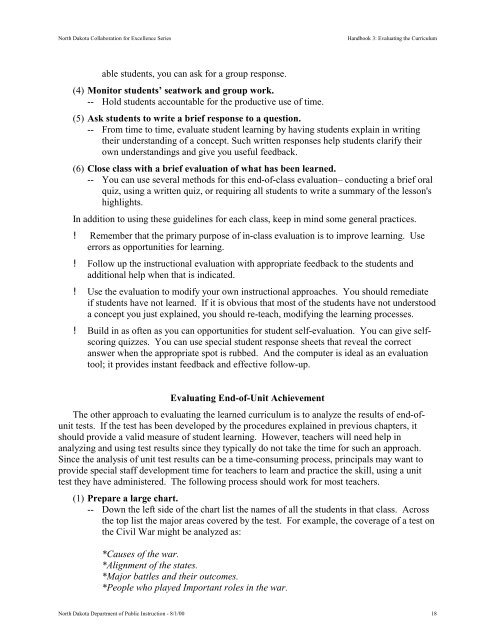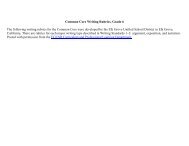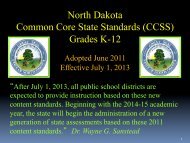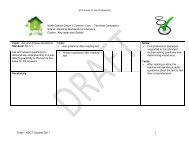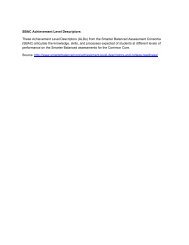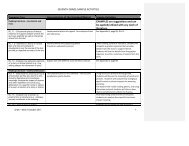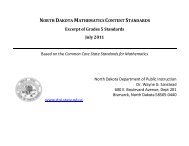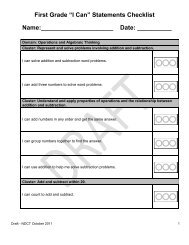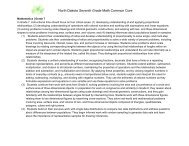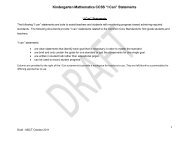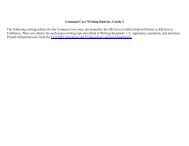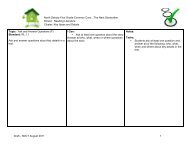Sample Scope and Sequence Chart - ND Curriculum Initiative
Sample Scope and Sequence Chart - ND Curriculum Initiative
Sample Scope and Sequence Chart - ND Curriculum Initiative
You also want an ePaper? Increase the reach of your titles
YUMPU automatically turns print PDFs into web optimized ePapers that Google loves.
North Dakota Collaboration for Excellence Series<br />
H<strong>and</strong>book 3: Evaluating the <strong>Curriculum</strong><br />
able students, you can ask for a group response.<br />
(4) Monitor students’ seatwork <strong>and</strong> group work.<br />
-- Hold students accountable for the productive use of time.<br />
(5) Ask students to write a brief response to a question.<br />
-- From time to time, evaluate student learning by having students explain in writing<br />
their underst<strong>and</strong>ing of a concept. Such written responses help students clarify their<br />
own underst<strong>and</strong>ings <strong>and</strong> give you useful feedback.<br />
(6) Close class with a brief evaluation of what has been learned.<br />
-- You can use several methods for this end-of-class evaluation– conducting a brief oral<br />
quiz, using a written quiz, or requiring all students to write a summary of the lesson's<br />
highlights.<br />
In addition to using these guidelines for each class, keep in mind some general practices.<br />
! Remember that the primary purpose of in-class evaluation is to improve learning. Use<br />
errors as opportunities for learning.<br />
! Follow up the instructional evaluation with appropriate feedback to the students <strong>and</strong><br />
additional help when that is indicated.<br />
! Use the evaluation to modify your own instructional approaches. You should remediate<br />
if students have not learned. If it is obvious that most of the students have not understood<br />
a concept you just explained, you should re-teach, modifying the learning processes.<br />
! Build in as often as you can opportunities for student self-evaluation. You can give selfscoring<br />
quizzes. You can use special student response sheets that reveal the correct<br />
answer when the appropriate spot is rubbed. And the computer is ideal as an evaluation<br />
tool; it provides instant feedback <strong>and</strong> effective follow-up.<br />
Evaluating End-of-Unit Achievement<br />
The other approach to evaluating the learned curriculum is to analyze the results of end-ofunit<br />
tests. If the test has been developed by the procedures explained in previous chapters, it<br />
should provide a valid measure of student learning. However, teachers will need help in<br />
analyzing <strong>and</strong> using test results since they typically do not take the time for such an approach.<br />
Since the analysis of unit test results can be a time-consuming process, principals may want to<br />
provide special staff development time for teachers to learn <strong>and</strong> practice the skill, using a unit<br />
test they have administered. The following process should work for most teachers.<br />
(1) Prepare a large chart.<br />
-- Down the left side of the chart list the names of all the students in that class. Across<br />
the top list the major areas covered by the test. For example, the coverage of a test on<br />
the Civil War might be analyzed as:<br />
*Causes of the war.<br />
*Alignment of the states.<br />
*Major battles <strong>and</strong> their outcomes.<br />
*People who played Important roles in the war.<br />
North Dakota Department of Public Instruction - 8/1/00 18


